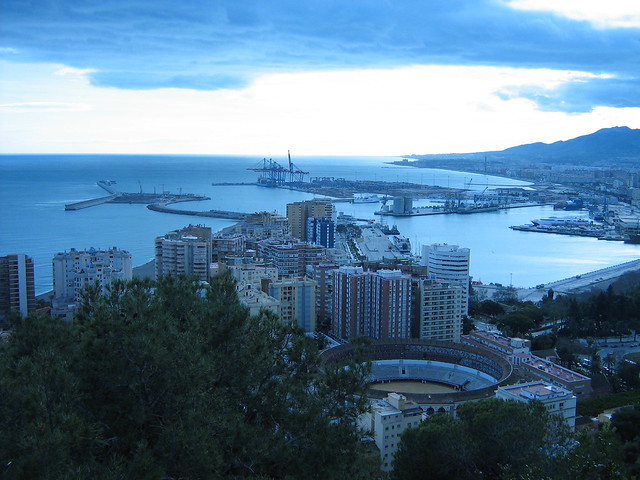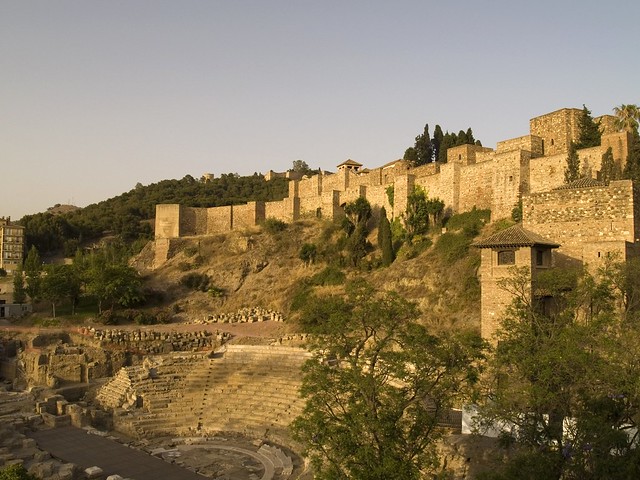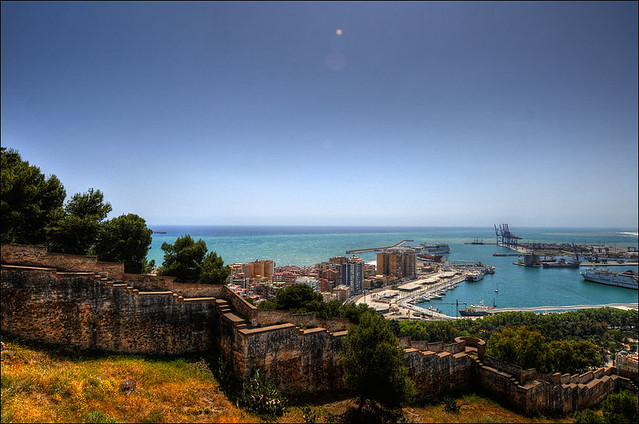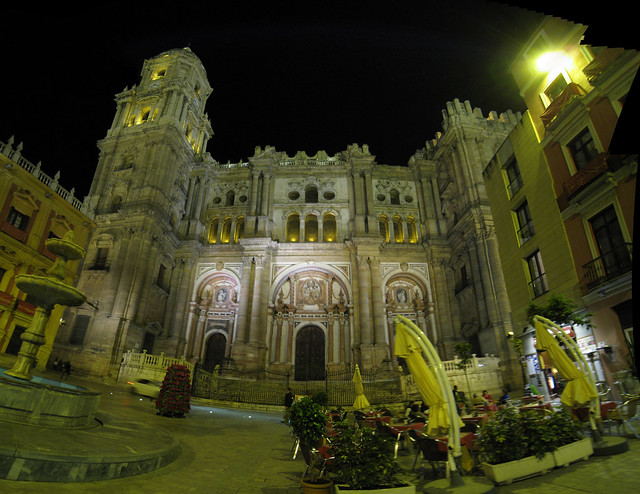The smallest of Andalucía’s eight provinces, Málaga is also its most populous, swelling to bursting point with the sheer weight of visitors in high summer. Although primarily known as the gateway to the Costa del Sol and its unashamedly commercial resorts such as Torremolinos and Marbella, the province has much more to offer than just its coastline. To most incoming tourists the provincial capital Málaga is merely “the place by
the airport”, but it’s also a vibrant city in its own right, with a population of half a million.
Conveniently, flight deal publishers such as CheapFlights offer lots of great deals on flights to Malaga (check it out here). From the airport, the electric train, Ferrocarril, provides the easiest and cheapest way into town. First impressions of Málaga are not encouraging. A large and bustling seaport with a population passing half a million, it’s the second city of Andalucía, after the charming city of Seville, and also one of the poorest, with unemployment numbers persistently among the highest in the region. Yet, though many visitors get no further than the train or bus stations, put off by the grim clusters of high-rises on the fringes, if you penetrate beyond these you will find yourself in one of the most atmospheric and historic cities in Spain. Lorca described Málaga as his favourite town and, given a chance, it can be a surprisingly attractive place, an impression boosted by the ebullient and big-hearted malagueños, among the friendliest people in Andalucía.
Around the traditional fishing villages of El Palo and Pedregalejo, now absorbed into the suburbs, is a series of small beaches and a paseo lined with some of the best fish and seafood cafés in the province. Overlooking the town and port, the Moorish citadels of the Alcazaba and Gibralfaro are excellent introductions to what you can expect at Córdoba and Granada, and while sevillanos loudly proclaim that there is only one Semana Santa worthy of the name, malagueños furiously disagree. The processions are celebrated here with great fervour and with much larger floats than those of Seville, carried by up to two hundred sober-suited males or robed penitents. In mid-August, at the peak of the tourist season, the town lets rip in its Feria de Málaga – one of the wildest and most spectacular fiestas in Andalucía.
Incidentally, Picasso was born in Málaga, and although the artist moved away in his early years, you can still visit his birthplace as well as the spectacular Museo Picasso Málaga housing a collection of his major works.
Málaga is bisected by the seasonal Guadalmedina river. All the major sights lie to the east of this and below the Alcazaba. From the Alameda, the city’s main thoroughfare, the cathedral, Museo Picasso and a clutch of interesting churches all lie within a few-minutes’ walk. The city has embarked upon a plan to revitalize the casco antiguo (old town) by pedestrianizing and refurbishing much of the monumental zone and laying with marble the whole of c/Marqués de Larios – a fashionable shopping street – and the focal Plaza de la Constitución. This regeneration program is now well advanced and is set to transform central Málaga in the years ahead.
Alcazaba
Málaga’s magnificent Alcazaba and Gibralfaro are an exuberant contrast to the dour fortresses of Castile. At the Alcazaba’s entrance stands a Teatro Romano, unearthed in 1951 during building works. The theatre, constructed in the second century BC, is now used as an auditorium for various outdoor entertainment. From here a path winds upwards, lined by the cypresses and flower-encircled arbours so loved by the sybaritic Moors. The citadel too is Roman in origin, and interspersed among the Moorish brick of the double- and triple-arched gateways are recycled blocks and columns of classical marble.
Although the Moors began building on the hill in the 700s, the Alcazaba with its interior palace as we see it today dates from the early decades of the eleventh century and was substantially restored and rebuilt in 1930. It was the residence of the Arab emirs of Málaga, who carved out an independent kingdom for themselves upon the break-up of the Western Caliphate during the same period. Their independence lasted a mere thirty years, but for a while the kingdom grew to include Granada, Carmona and Jaén. Strolling among the restored patios and terraces lined with cypresses, aromatic plants and ornamental pools the impression is of a smaller-scale Alhambra, and traces of stucco decoration surviving on the arches are similar to the artistry to be seen at Medina Azahara near Córdoba.
The recently refurbished small palace houses displays of ceramics found during archeological excavations. To reach the Alcazaba without the climb, you can use a lift constructed inside the hill itself. With its entrance on c/Guillen Sotelo, directly behind the Ayuntamiento, it transports you effortlessly upwards to emerge in the heart of the palace.
Gibralfaro castle
Above the Alcazaba, and connected to it by a long double wall (the coracha), is the Gibralfaro castle (same hours and entry charges as Alcazaba). It’s reached by climbing a twisting path that skirts the southern walls passing bougainvilleadraped ramparts and sentry-box-shaped Moorish wells. You can also approach from the town side, as the tourist coaches do, but this is a lengthy, rather unattractive walk and not one to be done alone after sundown. Built by Yusuf I of Granada in the fourteenth century and last used in 1936 during the Civil War, the castle, with its formidable walls and turrets, has, like the Alcazaba, been wonderfully restored and now houses an interesting museum dealing with the Gibralfaro’s history. Among a collection of military exhibits from all periods there is a splendid scale model letting you see how the city and Alcazaba complex would have looked in Moorish times. There’s also a display of seventeenth-century playing cards that were made in the factory in nearby Macharaviaya. A walk around the castle’s ramparts affords terrific
views over the city, the coracha, and the complex fortifications of the Alcazaba.
The Gibralfaro has its own bar, but while you’re up here, a pleasant place for a meal or a drink is the nearby Parador de Málaga–Gibralfaro, with its terrace overlooking the city. It’s reached by following the road leading out of the castle’s car park for 100m and turning right into the parador’s grounds. Next to the parador’s entrance is a mirador with a stunning view over the harbour, city and Plaza de Toros. If you’re feeling lazy, bus #35 from the Alameda Principal in the city centre will drop you by the castle entrance.
The Catedral
Dominating the views from the Gibralfaro is Málaga’s peculiar, unfinished Catedral. It lacks a tower on the
west front, the result of a radical malagueño bishop having donated the earmarked money to the American War of Independence against the British. Despite this curiosity, which has resulted in the building’s popular nickname La Manquita (“the one-armed lady”), the cathedral lacks much else of interest. The soaring interior is distinguished only by an intricately carved and naturalistic seventeenth-century sillería (choir stall) with outstanding sculptural work – in particular St Francis and John the Baptist – by Pedro de Mena. However, the Iglesia del Sagrario (same ticket and hours as cathedral; also open during services), on the cathedral’s northern flank, is worth a look, if only for its fine Gothic portal, dating from an earlier, uncompleted Isabelline church. Inside, a restored and magnificent gilded Plateresque retablo, which is brilliantly illuminated during services, is the work of Juan Balmaseda.
The Museo Picasso
Located just round the corner from the cathedral on c/San Agustín, is the Museo Picasso Málaga housed in an impressive sixteenth-century mansion – the former residence of the counts of Buenavista – with an elegant patio. A source of enormous pride for the city, the museum was opened by the king and queen in 2003, one hundred and twelve years after Picasso left Málaga at the age of ten and to where he returned only once for an unhappy, fleeting visit in 1901. In later life he toyed with the idea of sending “two lorries full of paintings” to set up a museum in Málaga but vowed never to visit Spain while General Franco was still alive – Picasso died in 1973 and was outlived by the dictator by two years.
The museum’s permanent collection consists of 204 works donated by Christine and Bernard Ruiz-Picasso, the artist’s daughter-in-law and grandson, while the temporary collection comprises loaned works and special exhibitions (not necessarily connected with Picasso). Whilst not on a par with the Picasso museums in Paris and Barcelona, it does allow you to see some of the lesser-known works that Picasso kept for himself or gave away to his lovers, family and friends – rather harshly described as “the less saleable stuff ” by one critic










No comments